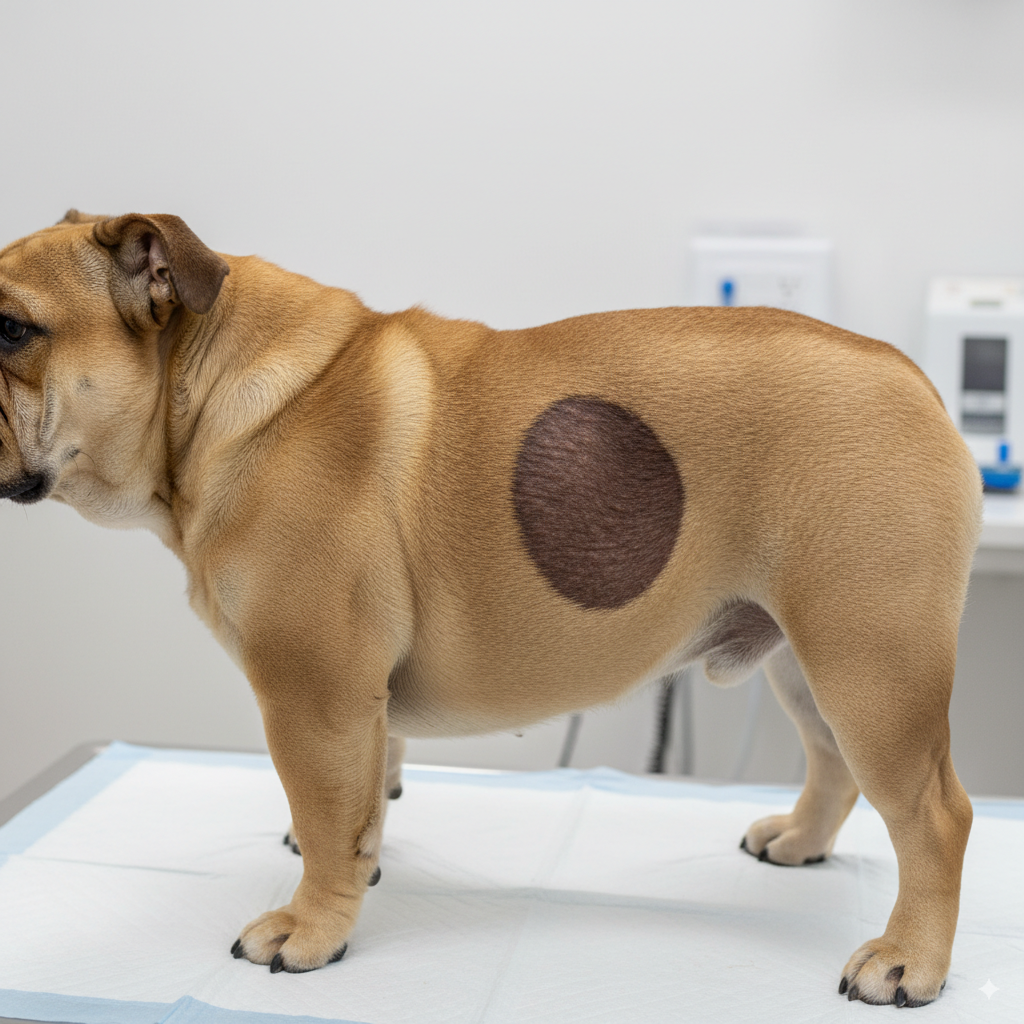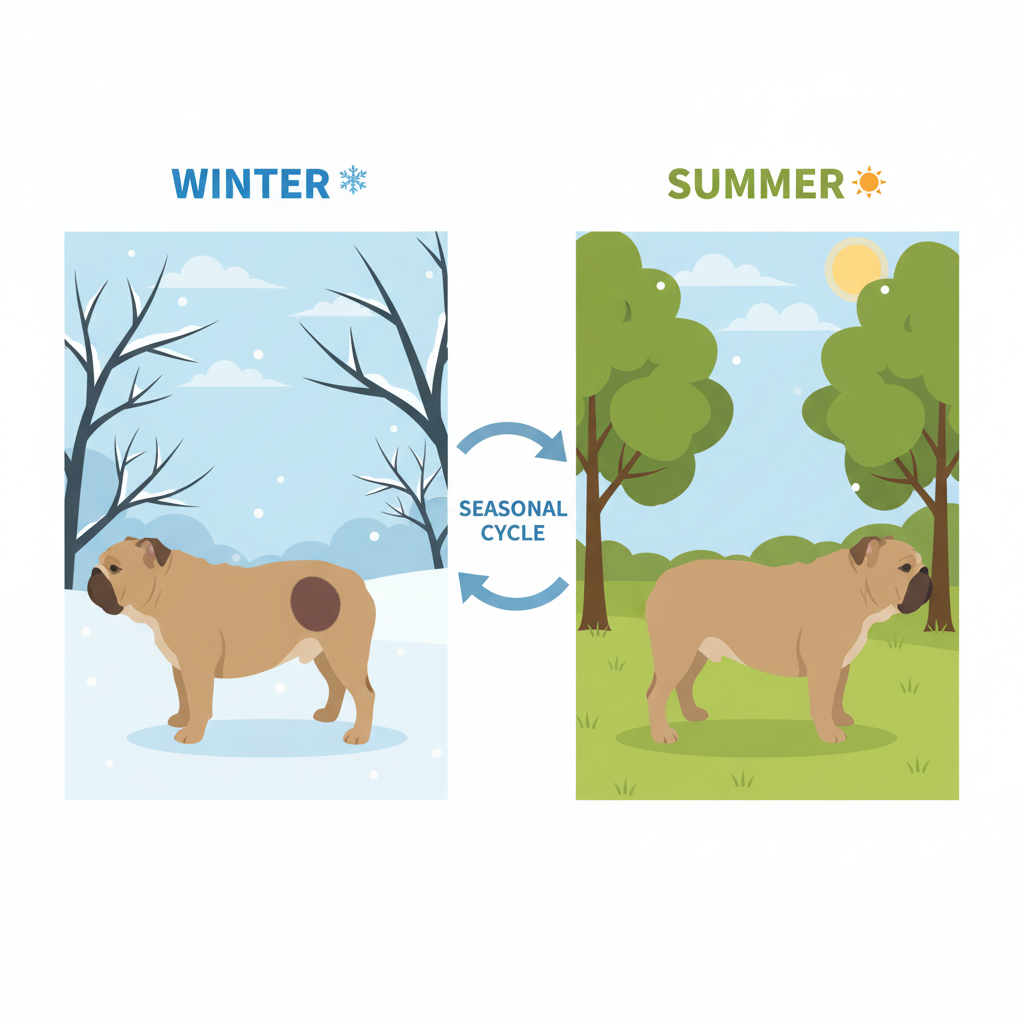Medical Disclaimer: This article is for informational purposes only and does not constitute medical advice. If you notice any new hair loss or skin changes on your dog, consult your veterinarian to ensure an accurate diagnosis.
In my veterinary experience, seeing a new patch of hair loss on your dog can be alarming. Your mind might jump to serious issues like allergies, infections, or hormonal diseases. But when a dog owner points to a perfectly symmetrical, bald patch that has appeared on their dog’s side as the days get shorter, I often start thinking of a much less worrying condition: flank alopecia.

Key Takeaways
Flank alopecia in dogs is a benign, cosmetic skin condition characterized by non-itchy, well-defined patches of hair loss on a dog’s sides or flanks. Often called “seasonal alopecia,” the hair loss typically occurs during the autumn or winter months when daylight hours are shorter, and in many cases, the hair spontaneously regrows in the spring. It commonly affects specific breeds like Boxers, Bulldogs, and Airedale Terriers. The exact cause isn’t known, but it’s linked to a dog’s response to light exposure. Diagnosis is usually based on the classic appearance and by ruling out other skin diseases. While it doesn’t harm the dog’s health, melatonin supplements are sometimes used to encourage hair regrowth.
Table of Contents
What is Flank Alopecia in Dogs? A Benign Condition
Flank alopecia in dogs is an unusual skin condition, but it is reported in an estimated 0.6–3% of dogs seen in dermatology practice. The medical term “alopecia” simply means hair loss. This specific type is also known as seasonal or recurrent flank alopecia because of its predictable, cyclical nature.
The most important thing for owners to know is that this condition is considered purely cosmetic. It does not cause your dog any pain, itchiness, or distress. The hair loss occurs because the hair follicles enter a dormant (telogen) phase prematurely, but the follicle itself is not damaged. The exact cause remains unknown, but the leading theory is that in susceptible dogs, the pineal gland’s response to decreased daylight exposure affects hair growth cycles.
Understanding the Seasonal Cycle of Hair Loss
The link to the seasons is the most defining feature of flank alopecia in dogs. In clinical reports, 90% of canine flank alopecia cases begin between November and March, aligning strongly with shorter daylight hours. Then, as the days get longer, the hair often regrows on its own, a process that can take three to six months. However, the new hair may come back with a slightly different colour or texture. In some dogs, the hair loss can become permanent over time, or the seasonal pattern can become less predictable.

Common Breeds at Risk for Flank Alopecia
While any dog can technically develop this condition, there is a well-documented breed predisposition, with Boxers representing about 48% of diagnosed cases in one UK study From my years in clinical practice, I’ve diagnosed flank alopecia in dogs most frequently in these breeds:
- Boxers
- Bulldogs (English and French)
- Airedale Terriers
- Schnauzers
- Doberman Pinschers
- Labrador Retrievers
The condition usually first appears in young to middle-aged dogs. Research into a genetic link is ongoing, but so far, no specific gene has been identified as the cause.
5 Telltale Signs of Flank Alopecia in Dogs
The clinical signs of flank alopecia in dogs are very distinctive. If your dog is showing the following combination of symptoms, this condition is high on the list of possibilities.
- Well-Defined Hair Loss: The hair loss occurs in a clear, almost “stamped-on” pattern. It can be a single patch or multiple areas, and the skin itself usually looks smooth and healthy, not inflamed or scabby.
- Located on the Flanks: As the name suggests, the hair loss is typically concentrated on the dog’s sides, in the area between the ribs and the hips. It can sometimes extend up toward the back.
- Symmetrical Appearance: The patches of hair loss often appear on both sides of the dog’s body in a roughly symmetrical pattern.
- Darkened Skin (Hyperpigmentation): The underlying skin in the bald patch often becomes darker than the surrounding skin. This hyperpigmentation is a common secondary change and is not a sign of a more serious problem.
- Completely Non-Itchy: This is a critical diagnostic clue. A dog with flank alopecia is not bothered by the patches. They do not scratch, lick, or chew at the areas of hair loss.
How Vets Diagnose Flank Alopecia: Ruling Out Other Issues
As a veterinarian, diagnosing flank alopecia in dogs is often a process of exclusion. The unique clinical signs—seasonal, non-itchy, symmetrical hair loss in a predisposed breed—are strong indicators. However, it’s my responsibility to make sure we aren’t missing another condition that presents with hair loss.

The first step is a thorough physical exam and taking a detailed history, paying close attention to the timing of the hair loss. Next, we must rule out other potential causes, such as:
- Hormonal Disorders: Conditions like hypothyroidism (low thyroid hormone) or Cushing’s disease can cause symmetrical hair loss. Blood tests are needed to rule these out.
- Mites (Mange): Demodex mites can cause patches of hair loss, though this is often accompanied by some inflammation. A skin scraping helps us look for mites under the microscope.
- Fungal or Bacterial Infections: Ringworm or a skin infection can cause circular patches of hair loss, but these are typically itchy or inflamed.
If the history and physical exam strongly point to flank alopecia in dogs, and the dog is otherwise healthy, further testing may not be immediately necessary. However, for a definitive diagnosis, especially in an unusual case, a skin biopsy can be performed. A small sample of the affected skin is sent to a pathologist, who can identify the characteristic changes in the hair follicles that confirm the diagnosis.
Treatment Options: Is Melatonin Effective for Flank Alopecia in Dogs?
Since flank alopecia in dogs is a cosmetic issue, treatment is not medically necessary and is often not pursued. However, some owners wish to encourage hair regrowth, and for this, melatonin is the most common and widely discussed option.

Melatonin is a hormone that plays a key role in regulating sleep and seasonal cycles. The theory is that by supplementing melatonin, especially during the darker winter months, we can help normalize the signals to the hair follicles and stimulate them to re-enter a growth phase. Its effectiveness varies; sResearch indicates that oral melatonin supplementation leads to full or partial hair regrowth in 50–75% of affected dogs, though it is not universally effective, but it does not work for every case.
From my veterinary experience, it’s a safe option to try for many dogs, but it is absolutely critical to a consult with your veterinarian before starting. They will need to provide you with a safe dosage based on your dog’s weight and health status, and recommend a reputable product. Human supplements are not always appropriate for pets.
Your At-Home Care Checklist for a Dog with Flank Alopecia
Managing flank alopecia in dogs at home is more about observation and routine care than intensive treatment. Here is a simple checklist to follow:
- Take Photos and Keep a Calendar: Document the hair loss when it first appears. Note the date and take a clear picture. This will help you and your vet track the pattern year over year and confirm if it is truly seasonal.
- Monitor the Skin: While the condition itself is not itchy, the exposed skin can become dry or sunburned. Check the patches regularly for any signs of irritation, redness, or sores, which would warrant a vet visit.
- Protect the Exposed Skin: Consider using a dog-safe sunscreen on the bald patches if your dog spends a lot of time outside in the sun. In cold Canadian winters, a coat or sweater can provide an extra layer of protection and warmth.
- Follow Veterinary Advice Exactly: If you and your vet decide to try melatonin, administer it exactly as prescribed. Do not change the dose or frequency without consultation.
- Focus on a Healthy Coat Overall: Ensure your dog is on a high-quality, balanced diet and consider a supplement with omega-3 fatty acids, which supports overall skin and coat health.
The Cost of Managing Flank Alopecia in Canada
While flank alopecia in dogs is not an expensive condition to manage long-term, getting a definitive diagnosis to rule out other diseases involves some initial costs.
| Service / Item | Estimated Canadian Cost Range | Notes |
| Initial Vet Consultation | $100 – $250 CAD | To perform a physical exam and discuss the history of the hair loss. |
| Diagnostic Tests | $200 – $500 CAD | Includes skin scrapings and blood work to rule out mites or hormonal diseases. |
| Skin Biopsy (if needed) | $500 – $1,000+ CAD | For a definitive diagnosis in atypical cases; includes sedation and pathology fees. |
| Melatonin Supplements | $20 – $50 CAD per month | Cost varies based on the dog’s size and the product used. |
Note: Most cases of classic flank alopecia do not require a biopsy. The diagnosis is often made based on history and clinical signs alone.
4 Simple Management Tips for Flank Alopecia
- Anticipate the Cycle: Once you establish your dog has a seasonal pattern, you can anticipate the hair loss. This helps reduce the anxiety that can come with seeing the bald patches reappear each year.
- Discuss Proactive Supplementation: Talk to your veterinarian about starting melatonin one to two months before the hair loss typically begins. Some vets find it can be more effective at preventing or reducing the severity of the hair loss when used this way.
- Choose a Gentle Grooming Routine: When bathing your dog, use a gentle, moisturizing shampoo to avoid drying out the exposed skin on the flanks.
- Embrace the Look: Remember that your dog is not aware of its cosmetic appearance. The most important thing is that flank alopecia in dogs is not harmful. As long as your vet has ruled out other medical issues, you can rest easy knowing your dog is perfectly healthy.
Frequently Asked Questions About Flank Alopecia in Dogs
Is flank alopecia in dogs serious?
No, it is considered a benign, cosmetic condition. It does not cause the dog any pain, itchiness, or illness and has no impact on their overall health or quality of life.
Does hair grow back after flank alopecia?
In most cases, especially in the first few years, the hair does grow back spontaneously in the spring and summer. The regrowth might be a different colour or texture. In some dogs, after many recurrent cycles, the hair loss can become permanent.
What happens if flank alopecia is left untreated?
Nothing harmful will happen. Since treatment is purely for cosmetic purposes, leaving it untreated simply means the hair loss will follow its natural, seasonal cycle. There are no medical consequences for forgoing treatment for flank alopecia in dogs.
How long does it take for melatonin to work?
If melatonin is going to be effective, you will typically see signs of hair regrowth within one to three months of starting the supplement. It does not work for all dogs, and its effects can sometimes diminish over time.
How We Researched This Article
To create this guide on flank alopecia in dogs, our content was developed and fact-checked by a licensed veterinarian. We grounded our information in trusted veterinary resources like VCA Animal Hospitals and PetMD, as well as peer-reviewed scientific literature to ensure all recommendations reflect the current, evidence-based standards of veterinary dermatology.
Conclusion
Discovering a bald patch on your dog can be unsettling, but a diagnosis of flank alopecia in dogs is almost always a sigh of relief. This quirky, seasonal condition is a cosmetic issue, not a health crisis. The key is to get a proper diagnosis from your veterinarian to ensure nothing more serious is being overlooked. Once confirmed, management is simple, stress-free, and focused on acknowledging that your dog’s unique seasonal look is just one more thing that makes them special.
References
- NDSR Team. (2021). Canine Flank Alopecia. North Downs Specialist Referrals. https://www.ndsr.co.uk/information-sheets/canine-flank-alopecia/
- Niskanen, J. E., GURGACZ, B., LUSH, J., DILLMAN, K., DONAHUE, A., & LOHI, H. (2024). Investigation of the association of the MLPH gene with seasonal flank alopecia in dogs. The Veterinary Record, e4208. https://pubmed.ncbi.nlm.nih.gov/39449035/
- Lee, M., Kim, H. W., Kim, J. H., Cho, H. G., & Seo, Y. (2022). Genomic and Transcriptomic Characterization of Atypical Recurrent Canine Non-Inflammatory Alopecia. Animals, 12(9), 1073. https://pubmed.ncbi.nlm.nih.gov/35456456/
- VCA Animal Hospitals. (2022). Seasonal Flank Alopecia. https://vcahospitals.com/know-your-pet/seasonal-flank-alopecia
- PetMD. (2023). Seasonal Flank Alopecia in Dogs. https://www.petmd.com/dog/conditions/skin/seasonal-flank-alopecia-dogs
- The Veterinary Nurse. (2021). Canine Flank Alopecia. Veterinary Practice. https://www.veterinary-practice.com/article/canine-flank-alopecia




